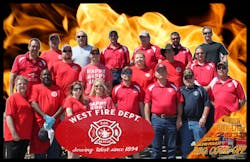Families Wait, But Know Last Alarms Answered in West, Texas
While the search for victims continues at a fertilizer plant in West, Texas, the families of three volunteer firefighters are already facing the grim reality that their loved ones have answered their final alarm.
Brent Bridges, 18, told the Star-Telegram that his father, Morris Bridges, was told that he probably didn't survive.
Robert and Doug Snokhous, brothers, are also among the volunteer firefighters unaccounted for.
Mayor Tommy Muska told reporters at The Wall Street Journal that among those already confirmed dead were five volunteer firefighters, four medical personnel and a Dallas Fire-Rescue captain who lived in West. City Secretary Joey Pustejovsky is also missing.
Marqee Snokhous, who lives in Florida, told reporters she spent the early morning calling every hospital in hopes of finding that her father, Robert Snokhous, and uncle were among the injured.
Her calls haven't panned out, and as of 12:30 p.m. Thursday, she said the family still had not received confirmation about the fate of her father or uncle.
“There’s not been anything official but the mayor did call my stepmom,” she said. “He told her that he’s pretty sure that they’re both inside the business in the plant, trapped in there. And that there’s a pretty high probability that there’s no survivors there.”
Authorities have been gingerly searching the site as well as nearby buildings looking for victims killed in the blast that registered 2.1 on the Richter scale.
The West Volunteer Fire Department says it has 33 firefighters.
Among them are Mayor Tommy Muska whose helmet was blown off by the blast.
In the seconds after the explosion, a voice heard on the radio says they need as many ambulances as possible.
The West Volunteer Fire Department was established in 1894 as the West Hose Company #1. The first equipment for West Hose Co. #1 was a Hose Reel drawn by a rope tied to a volunteer’s saddle horn.
In the late 1890s, the equipment was upgraded to a fire wagon drawn by a black stallion. By the turn of the century a two horse “Modern Seagraves” Fire Carriage was purchased. In 1915 the first motorized apparatus was purchased – a Cadillac Hose Truck with a 40 gallon chemical tank. The first “pumper” for the Fire Dept was a 1925 Reo with a 500 gpm (gallons per minute) pump. In 1929 a Ford Model A was added to the Fire Dept. fleet.
